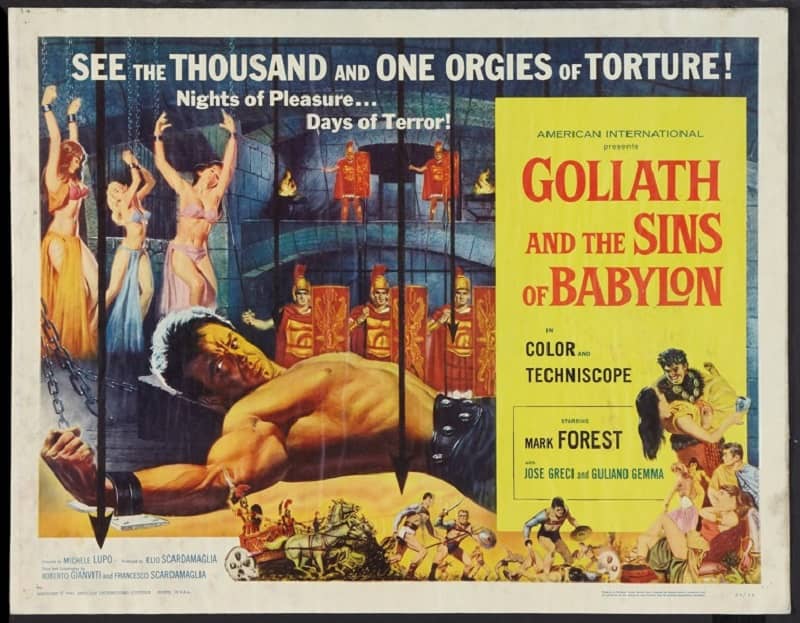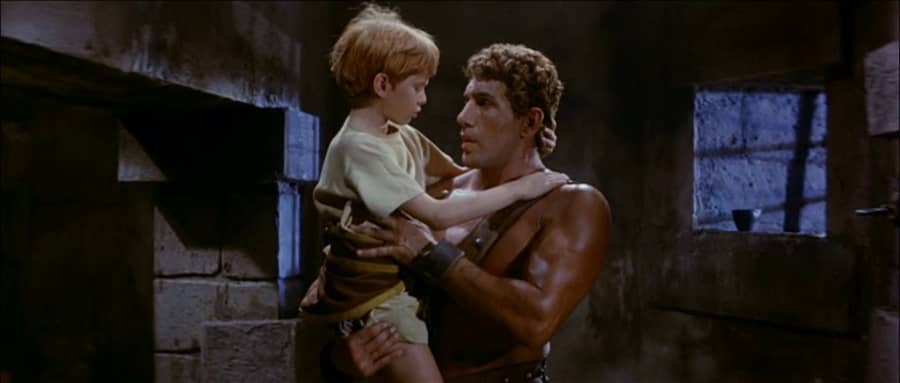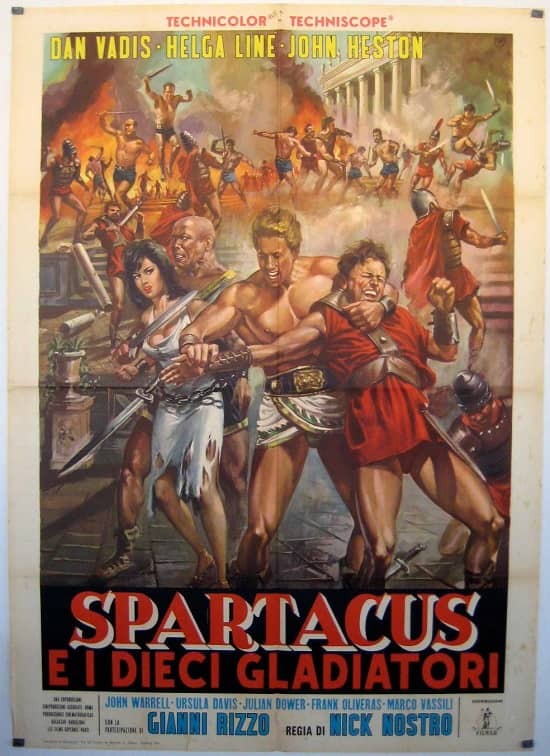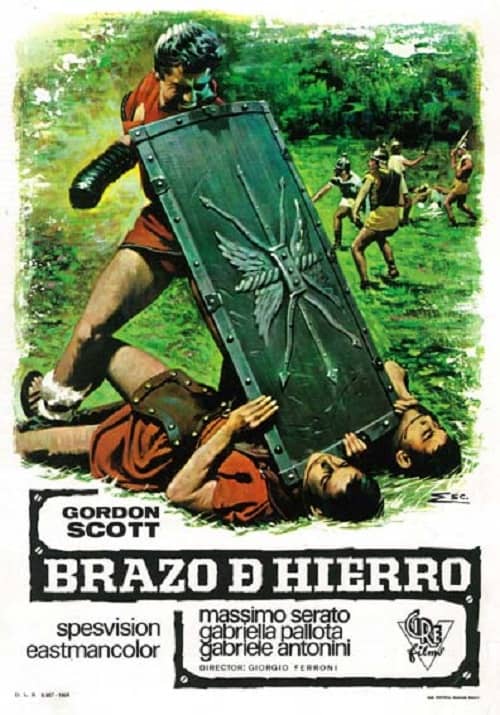Ellsworth’s Cinema of Swords: Premium Peplum
(Goliath and the Sins of Babylon, Italy, 1963)
If you like this kind of thing, this is the kind of thing you’ll like. Between 1959 and 1964, the leading genre of Italian adventure films was the peplum, or sword and sandal movie. The fad for these began in 1958 with the first Steve Reeves Hercules film, and there were a whole lot of Hercules films to follow, but we’re going to save those for another day and cherry-pick our way through the non-Herc movies. Peplum films tended to be made quickly and cheaply: indifferently written, poorly acted, and with weak production values. Even those with larger budgets often ran aground on the rocks of tedium and cliché. But there were a few silk purses among the sow’s ears, so this week let’s point out some fun exceptions that might be worth your time. If, you know, this is the kind of thing you like.
Goliath and the Sins of Babylon
Rating: ***
Origin: Italy, 1963
Director: Michele Lupo
Source: Retromedia DVD
If you like any of the later peplum epics, you’ll like this one, because it’s as good as they get. It stars one of the best strongman heroes in Mark Forest as Goliath/Maciste, and the visuals are an undeniable success on the level of sheer spectacle. Oh, sure, the story is utterly clichéd, with the ancient city of Nefir ruled by a puppet king controlled by the tyrannical Babylonians, whose tyranny is opposed by a desperate group of rebels who also happen to be shirtless muscleman gladiators. There’s a comic dwarf sidekick who’s even more embarrassing than most, and the tone varies wildly between wacky slapstick and grim vengeance, but the good stuff more than balances that out. Drawing inspiration from Ben-Hur (1959), there’s a sea battle between a galley with a lion-headed ramming prow and a towering Babylonian trireme that’s genuinely exciting, though the fighting savors more of professional wrestling than of gladiatorial combat. And in a full-scale hippodrome, there’s a deadly chariot race that the rebels must win because if the victor beats the Princess of Nefir, who drives her own chariot, he gets to wed her and become Nefir’s new king. (I’m sure that’s a historically authentic practice. Well, pretty sure.) And there are any number of dark dungeons with plummeting portcullises, steel-spear deathtraps, and inflammable bridges over abysses.
The gaudy costumes are less Ben-Hur than Flash Gordon, gleaming with barbaric bling; the black-clad Babylonian royal guard wear Evil Armor™, but the good guys just need leather straps and half-tunics (at best), because gladiators. The direction is actually pretty sharp and dynamic, the scenes are well framed, and the action pauses only to build tension before the next outburst of rebel guard-thrashing. There’s even an obvious but serviceable romantic subplot in which the rebel chariot-driver Xandros (Giuliano Gemma) falls for the handmaiden of Princess Regia (José Greci) without realizing she’s really the princess in disguise, but is then wounded by assassins so that Goliath has to take his place in the race. Angsty!
After the rebels put things right in Nefir the struggle moves to Babylon and the plot unravels under the weight of its many improbabilities, but Mark Forest is still charming even when he’s angry, there’s another pitched battle in the palace dungeons, and Nefir’s cavalry comes galloping across the deadly Desert of Gore (“Impossible!” cry the bad guys) just in time to save the day and, um, sack the city and put the Babylonians to the sword. But hey, they had it comin’.
The Vengeance of Ursus
Rating: ***
Origin: Italy, 1961
Director: Luigi Capuano
Source: Mill Creek DVD
This is smarter than your average shirtless strongman peplum. Though set in an uncertain classical time in two unknown kingdoms, everything else about this tale is well grounded and relatively believable. Disappointed in love, Ursus the mighty warrior (“Samson” Burke) has retired after mighty warring to plow his modest farm and raise his young brother Dario (Roberto Chevalier). Their bucolic existence is disturbed by the arrival of Ursus’s lost love, Princess Sira (Wandisa Guida), who is on her way to wed the neighboring monarch, King Zagro (Livio Lorenzon, always a pleasure). Suddenly, bandits! Ursus drives them off, but Sira’s guards are decimated, so despite his heartbreak, Ursus offers to escort her to Zagro’s capital.
Intrigue ensues. Zagro is a scheming rat who plans to marry Sira, assassinate her father, and then rule both kingdoms, ha ha ha ha! Complications to this scheme include his jealous mistress Sabra (Nadine Sanders), the mighty Ursus, and the hero’s young brother Dario, who unexpectedly turns out to be a clever and capable lad.
Ursus is a strongman on a more human scale that Hercules or Maciste: he can burst his bonds when he’s captured by his perfidious enemies, but it doesn’t look easy, and when he has to out-muscle eight other guys to avoid being pitched into a bonfire, he nearly doesn’t make it. Burke isn’t any better an actor than most of the American bodybuilders hired to star in these mini-epics, but at least his Ursus is given sensible motivations and decent lines to say, and that makes all the difference. The rest of the cast does even better, especially the villainous Zagro, who’s thoroughly convincing. Moreover, the action scenes are pretty credible, with soldiers wielding swords and shields as if they know what they’re doing. Plus, there’s an attack cheetah and an elephant. It may be hard to find a good surviving copy of this film but it’s worth the effort.
Spartacus and the Ten Gladiators
Rating: ***
Origin: Italy/France/Spain, 1964
Director: Nick Nostro
Source: Mill Creek DVD
Writer-director Nick Nostro thought it would be a good idea to use the heartbreaking saga of Spartacus’s slave revolt as the background for a light-hearted adventure romp, a buddy picture with ten shirtless pals beating the tar out of slavers and Roman guardsmen. And, son of a wolf, he was right!
The gladiator Rocca (Dan Vadis) and his nine interchangeable gladiator pals put on a good show in the arena at Capua, but then watch as a dozen mutinous Thracian gladiators are ordered to fight each other to the death. Halfway through that combat one of the Thracians refuses to fight on and the rest throw down their weapons as well. Despite Rocca’s protests, the impresario of the games wants the mutineers immediately put to death, but instead a brute named Chimbro (Milton Reid, you’ll recognize him) buys the Thracians for his master, Senator Varro (Gianni Rizzo). Thwarted, the impresario takes out his anger on Rocca and company, telling them they’ll never work in Italy again.
Ten unemployed gladiators in the Italian countryside, looking for love and a chicken dinner! Being good-hearted lugs, they rescue a snooty patrician woman from a gang of bandits; she turns out to be Senator Varro’s daughter and takes the gladiators home for dinner. During the meal, Chimbro comes in to report that he’s been unable to find the camp of the bandit Spartacus, so Varro recruits Rocca and company to take on the task, and since they don’t like bandits, they accept.
This movie is basically one exaggerated fight scene after another, with just enough connective tissue in between as a pretext for the next fight. Director Nostro is refreshingly unembarrassed about this: Chimbro tells Senator Varro that these gladiator dopes will never find Spartacus’s camp, and then cut! Rocca and company are looking down at Spartacus’s camp. The gladiators infiltrate the camp in an attempt to capture Spartacus (Alfredo Varelli), but he turns out to be the Thracian who refused to fight in Capua, and his ex-gladiator buddies quickly surround Rocca and company. Spartacus challenges Rocca to single combat and they fight … for a really long time. So long that everybody from both sides sits down to watch and enjoy it, as Rocca and Spartacus bond in manly fashion by wailing on each other until they’re staggering like drunkards. The fighters embrace, Rocca admits he was wrong about Spartacus, he falls in love with one of the ex-slave women at first sight, he and his buddies join the slave revolt, and everyone cheers.
The plot is even less credible from this point onward, but everyone’s having such a good time it would just be mean to complain. There are more captures, betrayals, escapes, gladiator commando raids, and clobbering of slavers on the regular, building up to a big set-piece battle between a Roman legion and Spartacus’s slave army. Things look dark for a while, young love is in peril, but the laughing gladiators win through and it’s entertaining despite being dumb. This is actually the third Ten Gladiators movie, but the first two don’t seem to be available in English versions, so you’ll have to be satisfied with this one.
Hero of Rome (or Arm of Fire)
Rating: ***
Origin: Italy/France, 1964
Director: Georgio Ferroni
Source: Mill Creek DVD
Gordon Scott had Tarzaned a lot in the Fifties, and then gone to Italy and Macisted for a while, but here he finally gets to put on a tunic. In this historical epic of early Rome, Scott plays Roman General Mucius, and in the first scene he fights off an Etruscan ambush on a food convoy almost single-handedly, wielding his gladius with skill. But he also does Mighty Feats of Strength like throwing whole tree trunks at the attackers, so at first the film looks like it’s shaping up to be just another strongman adventure.
But then things get interesting. The Romans have revolted against their Etruscan overlords, thrown out their last king, Tarquin (Massimo Serato, always a dependable villain), and declared themselves a republic. Tarquin has joined up with Porsenna (Rodalno Lupi), the Etruscan king, and their army has placed Rome under siege. Outnumbered, supplies dwindling, Mucius decides Rome’s only hope is for him to sneak into Porsenna’s camp and kill him. But Mucius slays the wrong man, a mere aide, and is captured. Threatened with torture unless he reveals Rome’s military secrets, Mucius thrusts his own hand into a flaming brazier and holds it there until Porsenna, impressed, begs him to take it out.
There follows an engaging tale of romance, political intrigue, betrayal, and vengeance, as Porsenna and Mucius try to negotiate a peace but are repeatedly foiled by the plots of Tarquin, who not only wants Mucius dead, he also wants his fiancée, the lovely and spirited Cloelia (Gabriella Pallotta). The story twists and turns, but Mucius, his sword hand crippled, can’t get the upper hand over Tarquin until Porsenna’s son, Prince Arunte (Gabriele Antonini), persuades him to learn to fight left-handed—and to clad his useless right hand in a heavy metal gauntlet that can serve as both shield and truncheon. Cool! When speaking his lines, Scott is pretty wooden, but he’s a fine physical actor, and the training sequence is convincing. Mucius, his mojo restored, leads a commando raid to rescue Cloelia from Tarquin, followed by a pitched battle between the Romans and Etruscans and a climactic single combat between Mucius and Tarquin. And it’s a tough fight, but the victor finally wins … handily.
Where can I watch these movies? I’m glad you asked! Many movies and TV shows are available on disk in DVD or Blu-ray formats, but nowadays we live in a new world of streaming services, more every month it seems. However, it can be hard to find what content will stream in your location, since the market is evolving and global services are a patchwork quilt of rights and availability. I recommend JustWatch.com, a search engine that scans streaming services to find the title of your choice. Give it a try. And if you have a better alternative, let us know.
The previous installments in the Cinema of Swords include:
Bard’s Tales
Hu’s on First
Flynn’s Last Flourishes
Mighty Colossi And Hydrae
Rejecting Bushido (Part One)
Pirates — Italian Style
The Year of Camelot and Scarecrows
Rejecting Bushido (Part Two)
The Fall of the Hollywood Epic
Cheh’s On Second
En Garde, Old Boy
More Hammer Historicals
Zatoichi’s Finest
A Little History
Lone Wolf and Cub, Part I
LAWRENCE ELLSWORTH is deep in his current mega-project, editing and translating new, contemporary English editions of all the works in Alexandre Dumas’s Musketeers Cycle, with the fifth volume, Between Two Kings, coming in July from Pegasus Books in the US and UK. His website is Swashbucklingadventure.net.
Ellsworth’s secret identity is game designer LAWRENCE SCHICK, who’s been designing role-playing games since the 1970s. He now lives in Dublin, Ireland, where he’s writing Dungeons & Dragons scenarios for Larian Studios’ Baldur’s Gate 3.




Italian opera is NOT my thing, but Mark Forest was a successful opera singer and voice coach after his relatively short run in the peplum movies. Which was 99.9% of his acting career.
https://www.youtube.com/watch?v=y2PMtEuHQGc
Another Ellsworth’s Cinema of Swords??? Splendio!
Thanks again for pointing us towards movies that so often turn out to be hidden treasures. I’ve never heard of any of these films but they all sound like they’re worth tracking down. I’ll have to keep an eye out for the one with the attack cheetah and the elephant. That is cheetah as in fast feline, right? Not that Cheetah from Verona who…ahem.
“but the victor finally wins … handily.”
You ought to be ashamed of yourself.
I’ve seen and enjoyed Goliath and the Sins of Babylon but not the other three.
Imagine my delight when I discovered that all four were included in the chunky peplum collection ‘Warriors’, which has been sitting on my shelf for something close to 15 years.
The transfers are guaranteed to be not-good to dreadful, but with these movies you take what you can get. Appreciate your review of such obscure and unlikely films.